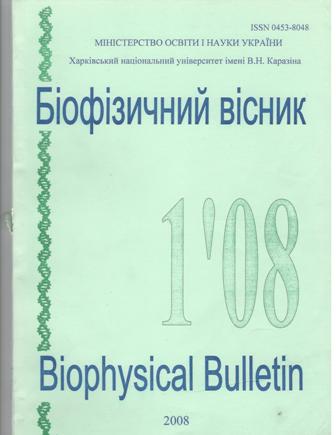Investigation of the effect of covalently attached phenazine dye on helix-to-coil transition in mixed poly (rA)-(dT)14 system
Abstract
The effect of imidazo-(4,5-d)-phenazine-N1-β-D-ribofuranoside (Pzn) covalently attached to 3'-end of (dT)14 on conformational transition in a mixed duplex system of poly(rA)•(dT)14 was investigated. The measurements were carried out in Na-cacodylate buffered solution, pH 6.9, containing 0.1 М NaCl, with polynucleotide concentration of 10-300 mkM base pairs. Formation of the poly(rA) complexes with (dT)14 and (dT)14Pzn was studied by thermal denaturation method based on the registration of melting curves by changes in the UV-absorption and the fluorescence intensity of attached phenazine dye. It was found that covalent attachment of imidazophenazin nucleoside derivative substantially increases the thermostability of duplexes formed by (dT)14 with the poly(rA), increasing the temperature of the helix-to-coil transition of 7°С due to intercalation of the dye chromophore between adenine bases. The thermodynamic parameters of helix-to-coil transition for systems studied were determined using the "all-or-none" model. It was shown, that the dye conjugation results in a decrease in the transition enthalpy. However, the observed gain in the free energy of complex formation, ΔG, is provided with the corresponding decrease in entropy change
Downloads
References
2. Cook P.D. // Anticancer Drug Des.-1991.- v.6, No.6.-p.585-607.
3. Milligan J.F., Matteucci M.D. and Martin J.C. // J. Medicinal Chem.-1993.-v.36.-p.1923-1937.
4. Helene C, Toulme J. // Biochim. Biophys. Acta.-1990.-v. 1049.- p.99-125.
5. Riordan M.L., Martin J.C. // Nature.- 1991.-v.350.-p.442-443.
6. Letsinger R.L., Schott М. Е. // J. Am. Chem. Soc-1981.- v.103, No. 24.- p.7394-7396.
7. Asseline U., Delarue M., Lancelot G., Toulme F., Thuong N.T., Montenay-Garestier T., Helene C. // Proc. Natl. Acad. Sci. USA.-1984.- v. 81, No 11.- p.3297-3301.
8. Dubey I.Ya. // Ukr. Bioorg. Acta.- 2006.-v. 1 .-p.42-59.
9. Shaw J.P., Kent К., Bird J., Fishback J., Froehler B. // Nucl. Acids Res.-1991.-v. 19, No.4.-p.747-750.
10. Makitruk V.L., Yarmoluk S.N., Shalamay A.S. and Alexeeva I.V. // Nucl. Acids Symp. Ser.-1991.-V.24.-P. 244.
11. Edmonds M., Winters M.A. // Prog. Nucl. Acid Res. Mol. Biol.-1976.- v.17.-p.149-179.
12. Ahlquist P., Kaesberg P. // Nucl.Acids Res.- 1979.-V.7, No.5. - p. 1195-1204.
13. Нурмухаметов P.H. Поглощение и люминесценция ароматических соединений.- М.: Химия, 1971.-216 с.
14. Zozulya V., Shcherbakova A., Dubey I. // J. Fluorescence.- 2000.-v.10, No.1.-p.49-53.
15. Froehler B.C., Ng P.G., and. Matteucci M.D. //Nucl. Acids Res.-1986.-v. 14.-p.5399-5407.
16. Макитрук В. Л., Шаламай A.C., Кондратюк И.В.// Биополимеры и клетка -1997-V.13, №6, р.453-459.
17. Серебряный С.Б., Юфа П.А. // Укр. Хим. Журн.-1963.-т. 29.-c. 322-329.
18. Thuong N.T., Asseline U., Roig V., Takasugi M., Helene С. // Proc. Natl. Acad Sei. USA.-1987.-V.84.-p.5129-5133.
19. Cassani G.R., Bollum F.J. // Biochemistry.- 1969.- v.8.-No 10.-p.3928-3936.
20. Zozulya V.N., Blagoi Yu.P., Lober G., Voloshin I., Winter S., Makitruk V., Shalamay A. // Biophys. Chem.-1997.-v.65.-p.55-63.
21. Zozulya V., Blagoi Yu., Dubey I., Fedoryak D., Makitruk V., Ryazanova O., Scherbakova A. // Biopolymers (Biospectroscopy).-2003.-v.72.-p.264-273.
22. Applequist J. and Damle V. //J. Am. Chem. Soc-1965.- v.87.-p. 1450-1458.
23. Martin F.H., Uhlenbeck O.C., Doty P. //J.Mol. Biol.- 1971.- v.57(2).-p.201-215.
24. Asseline U., Delarue M., Lancelot G., Toulme F., Thuong N.T., Montenay-Garrestier T., Helene C. // Proc. Natl. Acad Sei. USA.- 1984,-v. 81.-p.3297-3301.
25. Löber G., Kittler L. // Studia biophysica.-1978.-v.73, No.1 .-p.25-30.
Authors who publish with this journal agree to the following terms:
- Authors retain copyright and grant the journal right of first publication with the work simultaneously licensed under a Creative Commons Attribution License that allows others to share the work with an acknowledgement of the work's authorship and initial publication in this journal.
- Authors are able to enter into separate, additional contractual arrangements for the non-exclusive distribution of the journal's published version of the work (e.g., post it to an institutional repository or publish it in a book), with an acknowledgement of its initial publication in this journal.
- Authors are permitted and encouraged to post their work online (e.g., in institutional repositories or on their website) prior to and during the submission process, as it can lead to productive exchanges, as well as earlier and greater citation of published work (See The Effect of Open Access).





